Rough diamond prices higher in 2016 as production cuts and restocking flip supply/demand
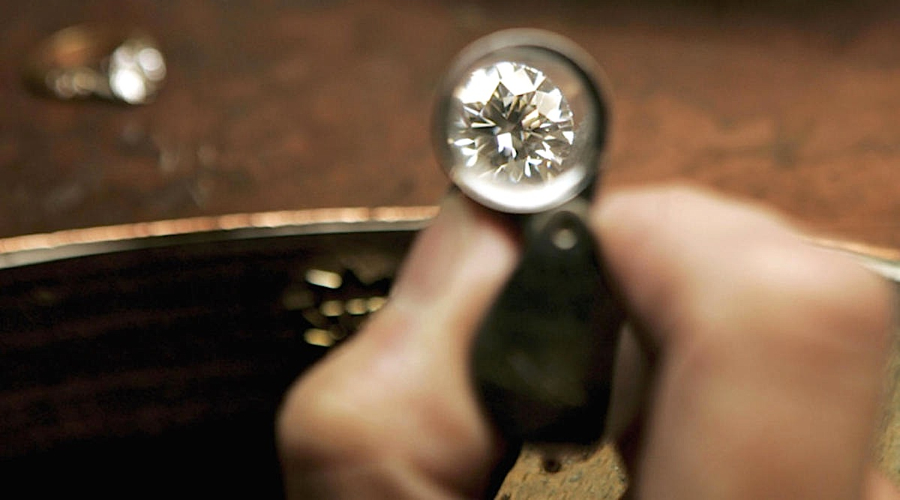
In 2016 the diamond industry has been marked by the follow-through of actions taken by De Beers, ALROSA (RTS: ALRS) and Rio Tinto (LSE: RIO) to curtail global supply, combined with a healthy 2015 retail holiday season that left the very cautious manufacturing segment of the industry under-stocked in early 2016.
Leading up to 2015, gross over-speculation of global diamond demand growth by some diamond cutters resulted in a significant overhang of low-to-medium-quality polished stock in the industry pipeline, which reached an apex about this time last year. The supply glut was debilitating, and even fatal, for the manufactures (the cutters) as there was in some cases no market for their freshly polished product which they needed to unload in order to pay back loans used to buy the rough. The bellwether producers (the miners) took action towards to end of last year in an attempt to normalize the supply/demand balance, in an effort to provide a lifeline to their clients. The producers took a two-pronged approach, reducing rough supply to the market, either through production cuts and/or inventory build, and reducing prices, with a goal of restoring the rough/polished price spread, essentially returning profitability to the manufactures.
Russian diamond super-major ALROSA lowered prices by 15% in 2015 and built inventory, selling less diamonds than it produced to reduce product in the market. As the supply/demand balance for rough and polished began to firm in early 2016, the company’s average price-per-carat sold went from $100/ct to $109/ct in Q1, to $127/ct in Q2, and to $117/ct in Q3, or up 9%, up 17%, and down 8%, respectively.
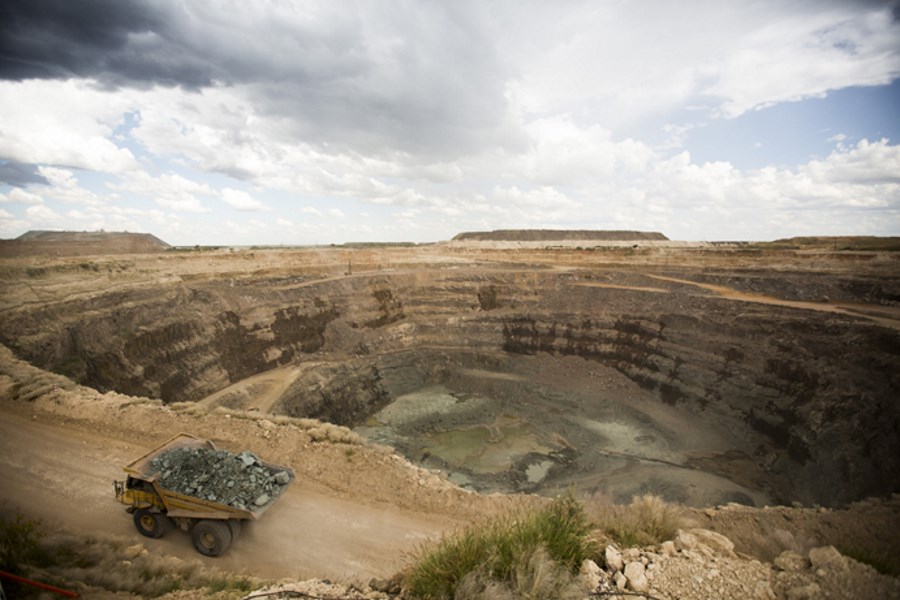
A haul truck at De Beers’ Orapa mine in Botswana. Source: De Beers Group.
The company recently indicated that their internal ‘like-for-like’ diamond price index was unchanged in 2016, despite the increase in average price per carat sold figures. Technically this difference can only be attributed to the range of product mix sold. If categories with price increases are being sold into the market, and categories with decreases are held back as inventory, the company’s price index does not necessarily reflect transactional price volume, and can be misleading. Product mix sold is dependent not only on what is offered by producers, but what is demanded by buyers at a given price, so average price-per-carat actually sold can a better indicator of true demand for product.
It is also worth noting that product mix should be less variable the larger and the more diversified the miner’s production stream, which is the case with ALROSA, the largest diamond producer in the world at the moment by volume and value sold. So while an average price-per-carat sold figure is not necessarily a perfect ‘like-for-like’ gage, the very high volume of diversified rough that ALROSA produces and trades has the potential normalize the metric over multiple operating quarters.
In the case of ALROSA, it is also interesting to note that the company reduced it’s inventory this year by about 10% through Q3 (approximately 9M additional carats, or 23% of estimated 2016 production volume), inventory which primarily consisted of smaller, lower quality stones for which there was relatively no market for in the second half of 2015, which would suppress the average price sold figure.
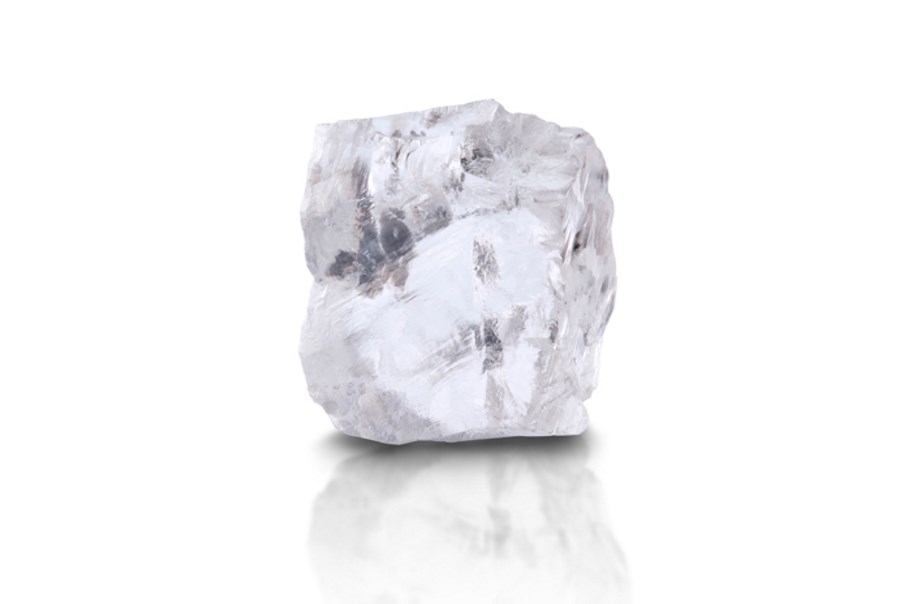
A 70 carat rough diamond from Rio Tinto’s Diavik mine in Canada. Source: Rio Tinto.
De Beers cut rough prices 3% in the spring of 2015 and then again 9% a few months later in August, and curtailed production 12% or ~4M carats in full-year 2015.
In January 2016 De Beers cut prices 7%, but then raised prices 2% in April, the company’s first price raise since 2014. Prices have since been unchanged. These four price adjustments net out to -17% over the last two years, comparable to ALROSA’s 15% cut in 2015.
Despite ALROSA and De Beers indicating that their ‘like-for-like’ diamond pricing is, respectively, unchanged and down in calendar 2016, market demand for rough is clearly up this year as evidenced by the robust uptick in gross sales revenue generated by the two majors.
ALROSA produced $4.2B in diamond sales so far this year, 21% higher than last year. The company’s cash flow has been so strong that they pre-paid $370M of debt in December, and have indicated that dividend increases are the best use for the company’s remaining ample excess cash on hand. Consequently, the stock is currently trading at an all-time high of 99 rubles a share in Moscow, equating to a market cap of 730B RUB (US$12B).
De Beers generated $5.6B in gross rough diamond sales in 2016 which is up 61% year-over-year. De Beer’s parent, Anglo American’s (LSE: AAL) stock, is trading at the highest level since Spring 2015 at 1,200 pence a share in London, a market cap of 16B GBP (US$13B). Last year Anglo restructured the company with a new focus on diamonds.
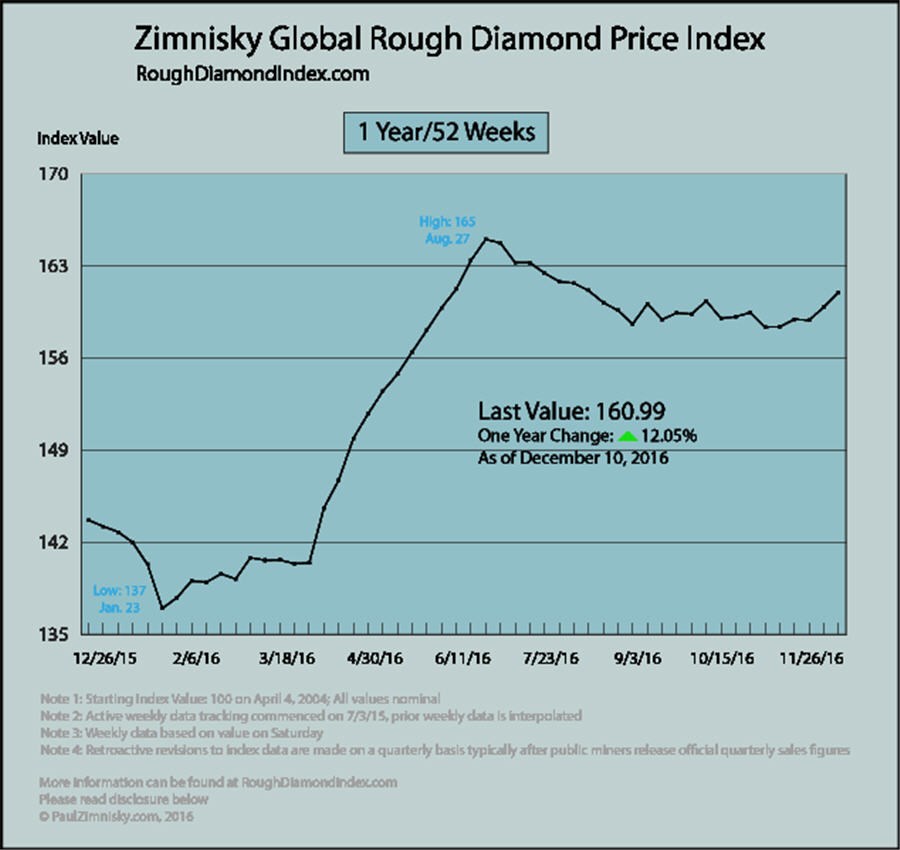
In addition, relatively healthy industry sentiment is mirrored by Rio Tinto, the second largest diversified miner in the world, which recently indicated that diamonds are a priority area of growth for the company, and single-asset producer Lucara (TSX: LUC) announced that it anticipates raising its regular annual dividend next year to C$0.10/sh from C$0.06. The stock currently trades at C$2.97.
The Zimnisky Global Rough Diamond Price Index is up 12.1% in 2016 through mid-December, driven higher in the first-half of the year as firm market demand for rough returned as manufactures restocked following the 2015 holiday season. The index peaked towards the end of June and has since retreated 2.4% from the high due to softening seasonal demand but also the demonetization in India which is primarily affecting lower valued goods purchased by smaller independent manufactures. The goal of the index is to track and aggregate transactional rough diamond data.
Note: Both ALROSA and De Beers have indicated that they price their rough according to their client’s (the manufactures) operating margins, market appetite gauged by tenders and auctions, and the polished market.
At the time of writing Paul Zimnisky held a long covered-call position in Dominion Diamond Corp
Paul Zimnisky is an independent diamond analyst and consultant and can be reached at www.paulzimnisky.com, and followed on Twitter @paulzimnisky
More News
Trump planning to stockpile deep-sea minerals to counter China: FT
April 13, 2025 | 07:56 am
Goldman Sachs upgrades gold forecast again to $3,700
April 12, 2025 | 08:05 pm
{{ commodity.name }}
{{ post.title }}
{{ post.date }}


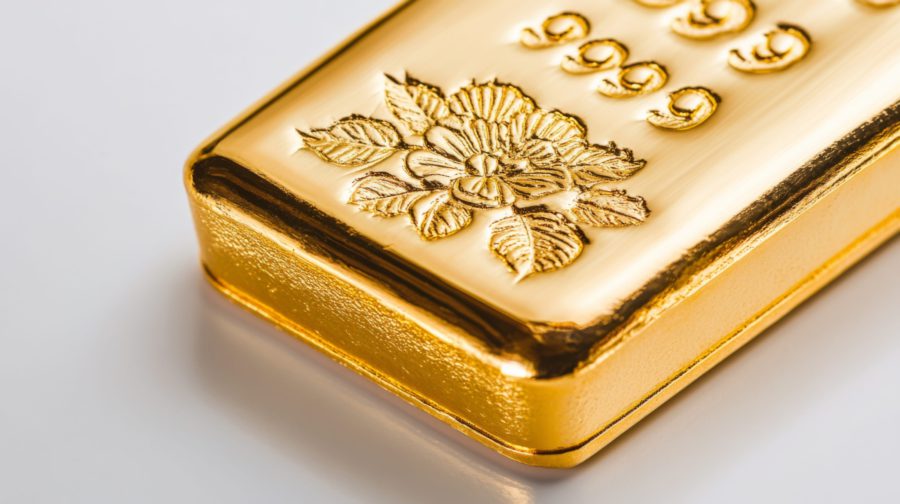

Comments